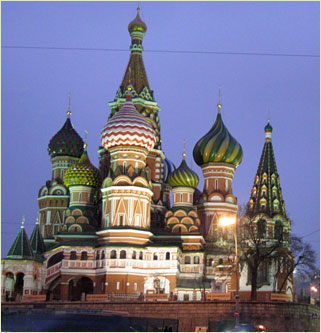|
Moscow is steeped in history. From medieval towers to the palaces of the Tsars, this beautiful city captures the imagination with its gilded domes and ancient cobbled streets. The capital of Russia, Moscow acts as the country’s principal political, economic, financial, educational and transportation center. The power and might of the Russian state developed in the halls of Moscow’s Kremlin and ancient locales. Located on the Moskva River, Moscow’s urban area constitutes about 1/10 of the entire Russian population, making it the most populous city in Europe.
The city has opened up over the last 25 years since the dissolution of the USSR in 1991. At the time, Russia was under Mikhail Gorbachev’s leadership. Gorbachev revolutionized the Russian political and financial state by bringing his country out from behind the “iron curtain” to establish it on the world stage as a competitive economy and a welcoming destination for visitors from across the globe. Moscow itself has produced an explosion of Western-style retailing, services, architecture and lifestyles. Well known for historical sites such as Saint Basil’s Cathedral and Red Square, visitors are greeted with a rich selection of sites and stories of the city and country’s turbulent past. The city’s official language is Russian, but like many modern societies across Europe, many people servicing the tourist industry have some English language skills.
|
|
Visitors to Moscow can spend weeks exploring the city and still not see everything of interest. Below we’ve listed a few “must-see” attractions to make your Moscow experience quintessentially Russian.
Red Square
Known as the historic heart of Moscow, much of Russia's turbulent history has been played out here. Whether done publicly in Red Square, or behind the intimidating walls of the Kremlin, there have been many great events played out here. As historical notes assert, the Red Square appeared at the end of 15th century, when Ivan III ordered to ruin all wooden buildings surrounding the Kremlin that would threaten it with the fire. The cleared area was to be used as a market square. Over the centuries Red Square transformed from market-place to execution-place to tourist attraction. From the north end of Red Square the visitor can see the familiar and easily recognizable multi-colored domes of St Basil's Cathedral looming on the far side of the square. Bordering the left side of the square is the vast pale edifice of the Historical museum and Upper Trade Rows (GUM) department store. On the opposite side of the Square are the towering walls of the Kremlin, beneath which sits Lenin's Mausoleum. Just to stand in the center of Red Square and take in the magnificent size and breadth of the area is worth the trip.
Kremlin
Like the adjacent Red Square, the Kremlin has been witness of many famous and tragic events of Russia’s history. Enemy guns rattled at its walls, celebrations and revolts took place within its battlements. These days the Kremlin acts as one of the biggest museums of the world for Russian state regalia, invaluable icons, and treasures of Russian Tsars. The most notable landmark of the Kremlin is the Spasskaya Tower, which is considered to be the most beautiful and most harmonious tower of the Kremlin. The Kremlin’s walls added two more features in the 15th century, with the Senatskaya and Nikolskaya towers. Now, of course, the Kremlin encompasses the Lenin Mausoleum.
St. Basil’s Cathedral
The unmistakable onion-shaped domes of the Cathedral of Intercession on the Mound, better known as St. Basil’s Cathedral, herald the rich religious history of the city. The initial concept behind this 16th century stone church was to build a cluster of chapels, one dedicated to each of the saints on whose feast day the tsar had won a battle, but the construction of a single central tower unifies these spaces into a single cathedral. A multi-tented church situated on the Red Square is traditionally perceived as symbolic of the unique position of Russia between Europe and Asia. The cathedral was commissioned by Ivan the Terrible and built between 1555 and 1561 in commemoration of the capture of Kazan. Located at the southeast end of Red Square, the Cathedral is just across from the Kremlin’s Spasskaya Tower. Not particularly large, it consists of nine smaller chapels built on a single foundation. For centuries pilgrims and the devoted have flocked to the site to worship and soak in the remarkable architectural feat that is St. Basil Cathedral.
Bolshoi Theater
Home of the world famous Bolshoi Ballet Company, the Bolshoi Theater dates back to 1825, when the current building was erected on the site of the Petrovsky Theatre, which had been destroyed by fire in 1805. The Bolshoi Theatre is considered to be the second largest of Europe after the "La Scala" Theater of Milan. The first performance to initiate the new theater was "The triumph of Muses". These days the theater plays host to performances from international artistic companies across the world. From masked balls to traditional ballet performances, today the ballet and opera fans attend the theatre every night. While visiting the Theater you may also be interested in The New Bolshoi theatre, adjacent to it. This theater continues to stage an extensive repertory of concerts and performances. While the ballet and dance performances are a little more expensive when compared to other Russian theatres, concerts and operas are still relatively affordable.
|



